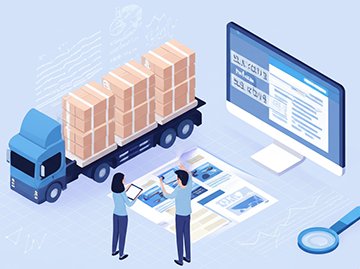Published: July 01, 2025 | Updated: October 23, 2025
Published: July 01, 2025 | Updated: October 23, 2025
Track and Trace: Enhancing Supply Chain Tracking and Transparency
 The system known as "The Track and Trace Process" offers an indispensable capability within supply chain management. This approach ensures complete visibility and accountability for products as they move from their initial point of origin to their ultimate destination. Businesses seek such capabilities for various compelling reasons, including safeguarding product integrity, adhering to strict regulatory requirements, and maintaining precise inventory control.
The system known as "The Track and Trace Process" offers an indispensable capability within supply chain management. This approach ensures complete visibility and accountability for products as they move from their initial point of origin to their ultimate destination. Businesses seek such capabilities for various compelling reasons, including safeguarding product integrity, adhering to strict regulatory requirements, and maintaining precise inventory control.
What is Track and Trace in Supply Chain Management?
Track and trace systems employ advanced technology to monitor product movement throughout the entire supply chain. This involves systematically capturing, securely storing, and readily retrieving data related to a product's journey. Such data encompasses its precise location, current status, and any significant events occurring along its path. The compiled information resides within a centralized database, allowing for immediate access and insightful analysis.
How Track and Trace Systems Work
The implementation of a track and trace system unfolds through a series of interconnected steps, each vital for comprehensive product oversight.
Product Identification
Each individual product receives a unique identifier. This identifier can manifest as a barcode, an RFID (Radio-Frequency Identification) tag, or a QR (Quick Response) code. This distinct marking enables accurate tracking of every item.
Data Capture
As a product progresses through the supply chain, specialized scanners or other data-capturing devices record its location and current status. This continuous data collection forms the backbone of the tracking mechanism.
Data Storage
The captured information finds a secure home in a centralized database. This repository acts as a comprehensive record of each product's journey, making information readily available for review.
Data Analysis
Analyzing the collected data provides valuable insights into a product's journey. This includes understanding transit times, assessing storage conditions, and identifying potential issues that may arise during transport or holding.
Visibility
With access to this data, businesses gain a real-time perspective on a product's exact location and status at any given moment. This immediate visibility enhances decision-making and responsiveness.
Track and Trace Applications by Industry
The track and trace process finds widespread application across numerous industries. Here are three prominent examples demonstrating its transformative impact.
Pharmaceutical Industry
Within the pharmaceutical sector, track and trace systems play a critical role in maintaining safety and compliance. These systems significantly deter the entry of counterfeit drugs into the market, ensuring product authenticity. In the unfortunate event of a product recall, workers can rapidly identify and remove affected products from circulation. This adherence to track and trace also assists companies in meeting the stringent requirements of regulatory agencies.
Food and Beverage Industry
In the food and beverage industry, track and trace greatly enhances food safety. The system helps pinpoint the source of foodborne illnesses by tracing the movement of contaminated items. Should a food recall become necessary, track and trace facilitates the swift and effective removal of affected products from the market. Moreover, this system promotes supply chain transparency, granting consumers access to information regarding the origin and journey of their food items.
Automotive Industry
The automotive industry leverages track and trace to elevate its operational efficiency. It contributes to improved inventory management and reduced lead times. By monitoring the movement of individual components, manufacturers can identify and resolve quality issues with greater effectiveness. In the context of a vehicle recall, track and trace enables rapid identification and notification of affected vehicles, ensuring a prompt response.
Benefits and Barriers of Track and Trace SystemsWhile track and trace offers substantial benefits, its implementation also presents certain challenges.
Advantages of Supply Chain Tracking
- Improved Visibility: Track and trace delivers real-time visibility into the location and status of products, providing unparalleled oversight.
- Enhanced Supply Chain Efficiency: By enhancing inventory management and shortening lead times, the track and trace system contributes to a more efficient supply chain.
- Improved Customer Satisfaction: The system boosts customer satisfaction by providing accurate delivery information and minimizing shipping delays.
- Risk Mitigation: Track and trace helps lessen risks such as product theft, counterfeiting, and the complexities associated with product recalls.
Challenges in Implementing Track and Trace
- Initial Investment: Establishing a track and trace system often requires a notable initial investment in hardware, software, and underlying infrastructure.
- Complexity: Track and trace systems can prove intricate to set up and maintain, particularly for extensive organizations managing complex supply chains.
- Data Security: Safeguarding sensitive data related to products and their movements demands diligent attention to data security protocols.
The Three Stages of Track and Trace
The comprehensive track and trace process typically unfolds in three distinct phases, each addressing a different segment of the product's journey.
External Tracing (Upstream)
The initial phase involves tracing raw materials back to their original vendors. Proper labeling plays a crucial role in identifying the specific manufacturer that supplied the raw materials. If any batches are deemed unsuitable for delivery due to substandard raw materials, track and trace allows for pinpointing the exact distributor who provided the problematic inventory. This upstream traceability ensures accountability from the very beginning of the supply chain.
Internal Tracing (In-Process)
Once raw materials move through production and assembly, they often combine to form a complete product. At this stage, serial numbers or batch numbers are assigned to each product or group of products. This internal tracing monitors progress throughout the production process. Companies operating across multiple facilities can leverage track and trace to oversee products as they move between different locations, maintaining continuous visibility within their own operations.
External Tracing (Downstream)
After production, the finished units are tracked as they transition from the warehouse to shipping, and ultimately, to the customer. Shipping companies often provide their own versions of track and trace services for each order. Customers can simply use the order number to monitor its status, gaining transparency on their delivery. This final phase of external tracing closes the loop on the product's journey, from creation to final delivery.
CMMS and Track and Trace: Integrating for Better Supply Chain Oversight
 A computerized maintenance management system (CMMS) can significantly enhance the effectiveness of the track and trace process through several key functionalities.
A computerized maintenance management system (CMMS) can significantly enhance the effectiveness of the track and trace process through several key functionalities.
Asset Tracking
A CMMS tracks the location and status of assets within the supply chain. This provides valuable data for track and trace initiatives, as the equipment used in the process itself can be monitored and managed.
Preventive Maintenance
By scheduling preventive maintenance tasks, a CMMS helps ensure the reliability of equipment essential for track and trace operations. Properly maintained scanners, sensors, and other devices function more consistently, supporting accurate data capture.
Data Integration
A CMMS can integrate with track and trace systems, providing a comprehensive view of the entire supply chain. This integration allows for a more holistic understanding of how maintenance activities impact product movement and data integrity.
Compliance Management
A CMMS generates documentation that auditors and regulators require. This documentation provides a clear record of maintenance activities, contributing to overall compliance with industry standards and regulations related to product traceability.
Advancing Supply Chain Tracking with Track and Trace
The track and trace process extends beyond simply monitoring product movement; it offers a profound opportunity for businesses to gain unprecedented oversight. This detailed approach allows organizations to cultivate an operation known for quality products and a culture of accountability. By providing a step-by-step visual flow of how equipment handles products, track and trace transforms theoretical control into tangible, verifiable management. This journey of transparency invites companies to not just observe their supply chain but to truly understand its pulse, fostering a future where every product's story is clear and complete.
Mapcon Technologies has developed a world-class system that has helped businesses for over forty years. 800-922-4336 Call today for a free demonstration.
FAQs
What is track and trace in supply chain management?
Track and trace monitors a product’s journey from origin to delivery, ensuring visibility, accountability, and regulatory compliance.
How does a CMMS enhance the track and trace process?
A CMMS, like MAPCON, tracks assets, schedules maintenance, and integrates with tracking systems to ensure accurate and reliable supply chain data.
Which industries benefit most from track and trace systems?
Pharmaceutical, food and beverage, and automotive industries use track and trace to improve safety, efficiency, and recall management.
What are the main advantages of implementing a track and trace system?
It improves product visibility, enhances supply chain efficiency, increases customer satisfaction, and mitigates risks such as theft and counterfeiting.
What challenges might companies face when implementing track and trace?
Challenges include upfront investment, system complexity, and ensuring robust data security protocols.
What are the three stages of track and trace?
The process involves upstream tracing of raw materials, in-process internal tracing, and downstream tracking of finished products to customers.
MAPCON CMMS software empowers you to plan and execute PM tasks flawlessly, thanks to its wealth of features and customizable options. Want to see it for yourself? Click the button below to get your FREE 30-day trial of MAPCON!
Try It FREE!